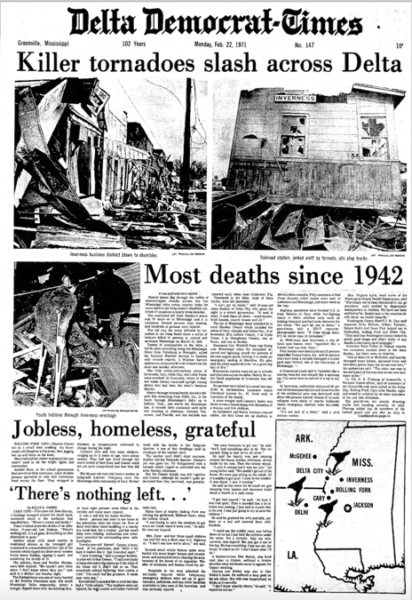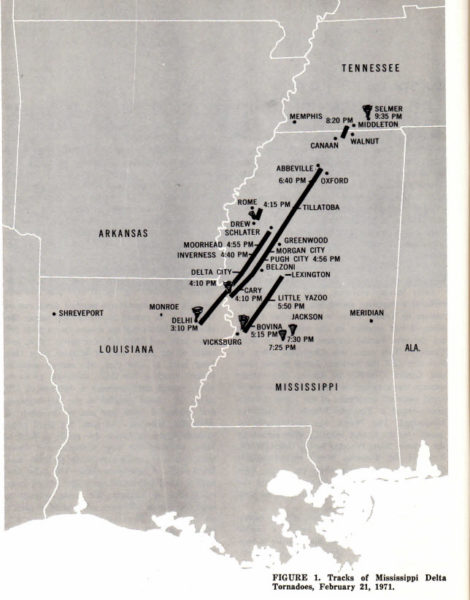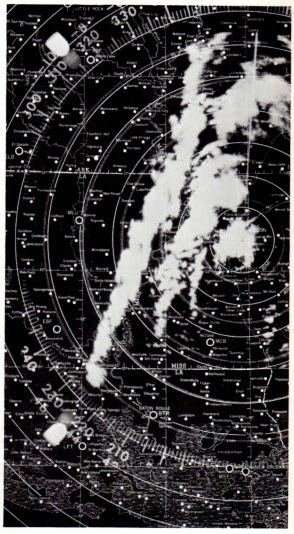2/21/1971: The Mississippi Delta Tornado Outbreak

The morning of Sunday, February 21, 1971 was a sleepy one across the Delta of Mississippi, a flat expanse of fertile soil. It was warm and humid, with temperatures in the middle 60s and dewpoints around 60 degrees. Radio reports told of a crippling snowstorm affecting Texas.
On the weather maps that morning, a surface low was over Central Texas near Waco. The low had caused severe weather overnight in the Hill Country. A warm front extended east from the low across northern Louisiana, Central Mississippi and into Alabama. That warm front was causing thunderstorms that were not severe. South of the boundary, winds were southerly and dewpoints were in the middle 60s at moist air surged northward.
At Jackson, Mississippi, thunderstorms were occurring with a temperature of 68F and a dew point of 66F. At New Orleans, it was 71F over 67F.
In the upper atmosphere, a highly amplified pattern was in place across the U.S. with a huge full latitude trough extending from North Dakota to New Mexico. The trough was progressing eastward. Ahead of it, a diffluent pattern aloft was in place over the Lower Mississippi Valley. This upper divergence would be a key factor in a significant tornado outbreak.
At the National Weather Service in Jackson, forecasters knew it was going to be a bad day. They called for thundershowers in their zone forecasts. Extra help was brought in for the event.
But Sundays in Mississippi were a sleepy time. Forecasts and statements highlighted the threat, but radio stations were broadcasting recorded programs. Most didn’t have a NOAA Weather Wire teletype drop anyway. Some had the Associated Press wire. The news departments in most television stations were not staffed. There was no NOAA Weather Radio.
The National Severe Storms Forecast Center in Kansas City was monitoring the situation. The morning Severe Weather Outlook Narrative called for a few severe thunderstorms during the afternoon in eastern Texas, Louisiana, south and central Arkansas, Mississippi, west and middle Tennessee and northwest Alabama.
At 9:55 a.m., tornado watch number 37 was issued for northern Mississippi. Just before 11 a.m., the first severe thunderstorm warning was issued by the NWS Jackson, for the Delta. A severe thunderstorm was indicated just west of Cleveland, MS.
At 11:17 the NWS offices in Jackson and Memphis conferred about issuing warnings. At 11:45 a.m., the NWS Jackson received a report from the PD at Cleveland in Bolivar County that a tornado had been spotted 6 miles SW of town. The severe thunderstorm warning was upgraded to a tornado warning. This would be the first of ten tornadoes that would strike the Delta that day.
By early afternoon, sunshine had driven surface temperatures to near 80 degrees across the Mississippi Delta. Instabilities were sky high and the diffluent pattern aloft made for an explosive situation. At 2 p.m., tornado watch number 39 was issued at 2 p.m. for eastern Louisiana and western Mississippi. At 3:05 p.m., the meteorologists at the NWS Shreveport observed an intense thunderstorm echo on their radar all the way across the state at Delhi. They contacted the Louisiana State Police and asked for a check on the storm. Seven minutes later, the troopers reported over the NAWAS circuit that there had been a tornado near Delhi. At 3:20 p.m., a tornado warning was issued for areas ahead of the storm.
The tornado touched down at 3:10 just east of Delhi and tracked into Mississippi. It would be on the ground for 102 miles. This would be the first of three great tornadoes that would touch down that day. This tornado virtually destroyed the town of Delta City in Sharkey County about 4:10 p.m., killing 8 people. The tornado watch had been in effect since 2 p.m. and a tornado warning since 3:20 p.m.

Inverness in Sunflower County was struck at 4:40 p.m., but still nineteen people perished. The tornado warning had been issued for Sunflower County at 4:15 p.m. That’s 25 minutes of lead time. The tornado watch had been in effect since 10 a.m.
Even as people were dying in Delta City, the second great tornado touched down at 4:10 p.m. near Cary, Mississippi and tracked northeast on a parallel course to the first big tornado, remaining on the ground for 159 miles. Fourteen people died in Cary, which had been under the same watch and warning as Delta City. At 4:30 p.m., the NWS Jackson tried to call the radio station at Belzoni, but the line was busy. They asked the Police Department to go to the radio station and issue the warning. Fifteen minutes later, a state trooper reported a tornado 3 miles southwest of Belzoni. Radar also indicated a hook echo. At 4:56 p.m., the tornado virtually destroyed Pugh City, where 22 people died. Pugh City had gone under a tornado warning at 3:37 p.m.

Jackson radar at 5:32 p.m.
At 5:15, the third huge tornado touched down near Bovina, Mississippi. It would remain on the ground for 69 miles. It would be 35 minutes before the monster tornado reached the town of Little Yazoo, Mississippi. At that point, Yazoo County had been under tornado warning since 4:15 p.m. Still, nine people died.
Satellite coverage by the ATS-3 satellite was scheduled to begin at the National Severe Storms Forecast Center in Kansas City on March 1. The equipment was in place, but the satellite picture processing team had not arrived yet. Pictures from the ATS would have been available from sunrise until late afternoon, in 12 minutes intervals, with the photos being available 40-45 minutes after the image was taken. Absolutely primitive by today’s standards.
Mississippi Highway Patrol officers were critical in the warning process. Most of the tornado reports were received from Highway Patrol officers. The NWS in Jackson provided annual training to officers.
Three of the tornadoes were F4s. A total of 121 fatalities were reported in Mississippi and Louisiana, making it one of the deadliest tornadoes outbreaks in United States history. A total of 110 died in Mississippi. Three of the tornadoes caused 118 of the deaths. Along with the fatalities, 1,600 were injured.
But heroic work by forecasters kept the death toll way lower than it would have been.
Category: Met 101/Weather History



















Comments (11)
Trackback URL | Comments RSS Feed
Sites That Link to this Post